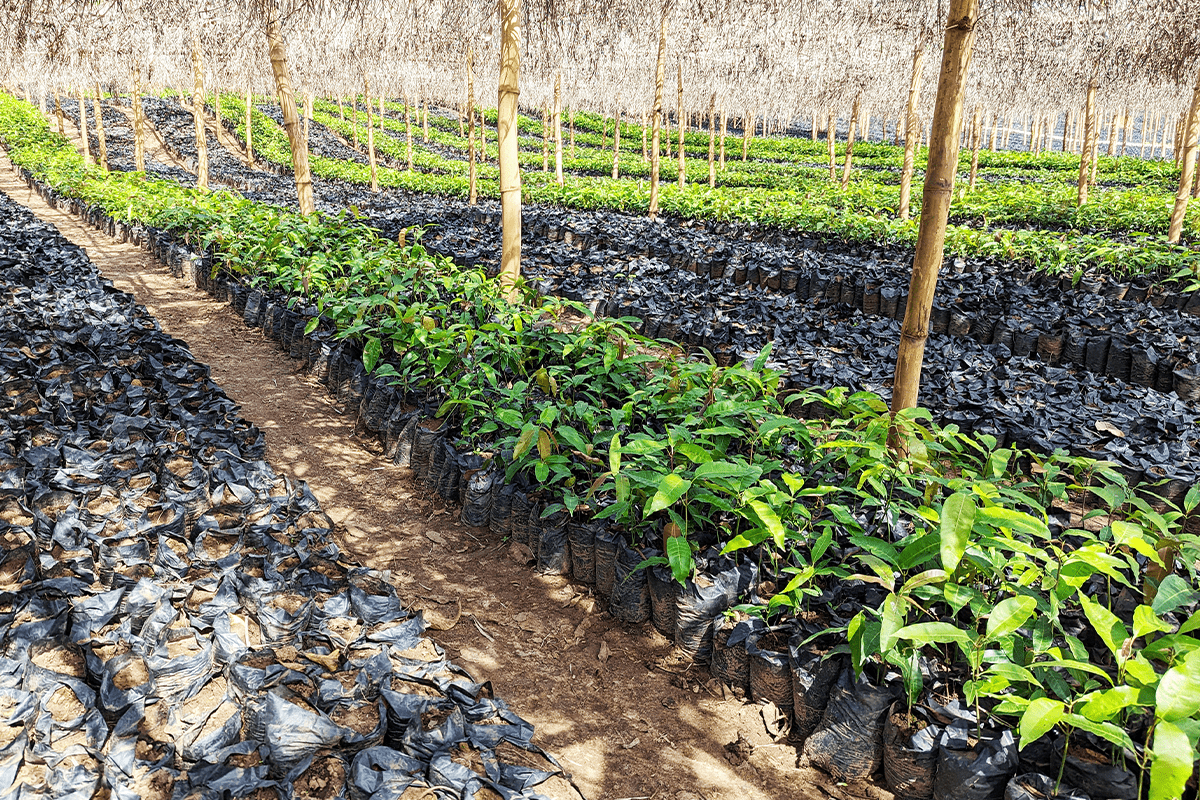The world is facing an urgent climate crisis, and the need for sustainable solutions has never been greater. One of the most ambitious targets that countries and organisations have set is achieving net-zero emissions. But with the scale and complexity of the challenge, many are left wondering: How can net zero be achieved? And, why should net zero be achieved?
 A close-up of a tree seedling - Tree Planting at Iruri Primary school in Kenya, DGB.
A close-up of a tree seedling - Tree Planting at Iruri Primary school in Kenya, DGB.
This article will explore the concept of net zero and examine the challenges and opportunities in achieving it. We will also look at some of the strategies that are being developed to reduce emissions and remove carbon from the atmosphere, including nature-based solutions. We will consider the role that individuals, businesses, and governments can play in transitioning to a net-zero future.
What is Net Zero?
Net Zero refers to the balance between the amount of carbon dioxide emissions produced and the amount removed from the atmosphere. In other words, it means achieving a state where the residual emissions produced are offset by removing an equivalent amount from the atmosphere, effectively resulting in no net emissions. This has become a critical effort in the quest for a greener future, and countries, organisations, and individuals are setting net-zero targets to achieve this balance in the coming years. Achieving net zero is critical in addressing the climate crisis and requires a range of measures, including significant changes in energy systems, land use, and industrial processes.
Achieve net zero with DGB
The benefits of achieving Net Zero
Achieving net zero emissions has numerous benefits for both the environment and society as a whole. Investing in nature-based solutions, transitioning to sustainable practices and clean energy sources, and reducing carbon emissions can help alleviate the negative effects of climatic emergencies, including higher temperatures and sea levels, more extreme weather events, and limited access to food and water. Reducing our carbon footprint also creates economic opportunities by developing new industries and jobs in various sectors. Additionally, adopting nature-based solutions and reducing our reliance on fossil fuels can contribute to better public health outcomes and improved environmental justice.
 Woman providing a tree planting exercise - Tree Planting at Iruri Primary school in Kenya, DGB.
Woman providing a tree planting exercise - Tree Planting at Iruri Primary school in Kenya, DGB.
A positive impact on climate
Achieving net-zero carbon emissions is essential for mitigating the worst impacts of climatic disasters. Net zero requires removing carbon emissions from the atmosphere equal to the amount produced by human activities through various measures, such as carbon capture and storage, afforestation, and the use of renewable energy sources. Carbon dioxide emissions absorb and radiate heat, therefore affecting global temperatures. The shift towards a sustainable, decarbonised future will therefore have a significant positive impact on the climate.
Measure your environmental impact
Limiting global warming to 1.5°C above pre-industrial levels, as outlined in the Paris Agreement, has a crucial impact on reducing extreme weather events. By achieving net zero, we are taking necessary steps to limit climate change, which will result in fewer natural disasters, such as hurricanes, floods, droughts, and other disasters that disproportionately affect vulnerable communities.
Net zero carbon emissions also have significant implications for food security and biodiversity. The agricultural sector, for example, is particularly vulnerable to the effects of extreme weather. By reducing emissions and transitioning to renewable energy and other sustainable practices, we can decrease the frequency and severity of extreme weather events resulting in crop failure and lost livestock. This, in turn, helps secure food supplies and preserve ecosystems.
 A woman checking the condition of seedlings - Audit of the Afforestation and Cookstove projects in Kenya, DGB.
A woman checking the condition of seedlings - Audit of the Afforestation and Cookstove projects in Kenya, DGB.
Moreover, the transition to renewable energy sources like wind and solar power can have significant health benefits by reducing air pollution. The burning of fossil fuels to produce energy releases particulate matter and other pollutants into the air, causing severe respiratory and cardiovascular health issues. By shifting to renewable energy sources, we can reduce the number of deaths and illnesses caused by air pollution.
Economic growth and job creation opportunities
Transitioning to a net-zero economy presents economic opportunities and job creation potential, in addition to achieving climate targets. Emerging industries like nature-based projects, renewable energy, green infrastructure, and carbon capture and storage (CCS) will experience growth, generating new employment opportunities and boosting local economies.
 Conversation between AENOR employees and DGB employees - Audit of the Afforestation and Cookstove projects in Kenya, DGB.
Conversation between AENOR employees and DGB employees - Audit of the Afforestation and Cookstove projects in Kenya, DGB.
The net-zero transition will necessitate changes in capital allocation and financing structures, with governments, private investors, and businesses investing in low-carbon technologies, carbon-removal projects, and renewable energy instead of fossil fuels. Divestment from carbon-intensive activities will enable the creation of new job opportunities and promote innovation. The transition will also require training a workforce with skills relevant to the twenty-first century, developing new technologies, and creating jobs that align with the requirements of a net-zero economy.
Read more: Investing for the good: How socially responsible investing is driving economic sustainability
Increased energy security and resilience
Achieving net zero can significantly increase energy security and resilience. Net-zero strategies involve diversifying energy sources and reducing reliance on fossil fuels, thereby improving a region's energy security and resilience while reducing carbon emissions. Energy diversification integrates multiple energy sources into a system. By diversifying the energy mix, regions improve their resilience to supply interruptions, price shocks, and carbon emissions. Recently, countries like Denmark and Germany have successfully diversified their energy mix, with renewable energy sources accounting for over 50% of their electricity production. This diversification has increased stability and flexibility and reduced reliance on fossil fuels.
Renewable energy sources are key to achieving net zero emissions. Unlike fossil fuels, they are inexhaustible, widely available, and have low or zero carbon emissions. These sources include solar, wind, hydro, and geothermal energy, which are abundant in many regions. For instance, the International Renewable Energy Agency (IRENA) reports that wind and solar energy sources are already cheaper than fossil fuels and could provide up to 75% of global electricity by 2050.
Explore how leading companies are achieving net zero
Protecting the environment and natural resources
The transition to net zero benefits the environment as it requires responsibly using and preserving natural resources. Proper management of land and forests and the responsible use of water resources play a critical role in reducing carbon footprints and generating carbon offset credits.
Sustainable land and forest management is necessary to preserve natural resources and biodiversity. Land management practices reduce deforestation, protect habitats, ensure sustainable water and soil quality, and increase land productivity. Strategies like agroforestry, which combines crops and trees on the same land, can help preserve forests and ecosystems while ensuring that the land remains productive. Healthy soils also sequester carbon dioxide, helping to reduce atmospheric emissions.
Land preservation efforts can also create and protect forests—which are vital carbon sinks and absorb large amounts of carbon dioxide. Forests are therefore critical natural resources in achieving net zero. Forests can also generate carbon offset credits, providing economic opportunities for investors and corporations. The sale of these credits incentivises forest preservation and restoration while providing an economic benefit to local communities.
 Aerial view of green mangrove forest, Amazon Rainforest.
Aerial view of green mangrove forest, Amazon Rainforest.
Water resources also play an essential role in achieving net zero. Proper water resource management can help reduce the carbon footprint of freshwater use. Sustainable water-use practices such as reducing water waste and wastewater treatment can help improve water quality and preservation.
Read more: 10 Agricultural techniques for water conservation
From an operations point of view, access to natural resources is required for technological advancements, supply chains, and support infrastructure. These include metals, rare earth minerals, and renewable energy sources such as solar and wind. Responsible management of these resources is essential to reduce the impact of mining and extraction on the environment while ensuring a sustainable supply chain.
Operational benefits
In addition to the climate, employment, energy, and environmental benefits offered by net zero, it can also have several operational benefits:
- It attracts investment. Investors increasingly consider environmental, social, and governance (ESG) factors when making investment decisions. When businesses demonstrate a commitment to sustainability, they differentiate themselves from their competitors and attract investment from responsible investors.
- It reduces costs. Businesses that become more sustainable and change their behaviour towards energy consumption and emission-producing activities decrease inefficiencies and operational costs, thus, increasing their revenue, efficiency, and competitiveness.
- It engages customers. Consumers are becoming more conscious of the environmental impact of their products and are willing to pay a premium for eco-friendly options. Businesses that become carbon neutral demonstrate their commitment to sustainability and connect with consumers who share their values. These businesses also attract new customer groups.
- Brand and growth development. Sustainable businesses benefit from improved brand recognition and growth. Brands that are known for being or becoming sustainable are more popular in the market. Sustainability also drives faster growh within businesees.
 Local woman with energy-efficient cookstove - Hongera Energy Efficient Cookstoves Project, Kenya, DGB.
Local woman with energy-efficient cookstove - Hongera Energy Efficient Cookstoves Project, Kenya, DGB.
Challenges in achieving Net Zero
Achieving net zero emissions can be a complex and multifaceted challenge that requires transformative changes across several sectors of the economy. Here are some of the challenges that need to be addressed to achieve net zero emissions:
- Transforming the energy sector. The energy sector is responsible for the largest share of global greenhouse gas emissions, and transitioning this sector to clean, renewable energy supplies such as wind, solar, and hydropower is critical to achieving net-zero emissions. However, this requires a massive overhaul of energy infrastructure, including developing new storage technologies and building new grids to transport energy.
Read more: The history and future of renewable energy
- Creating resilient nature markets. Nature-based solutions such as reforestation, afforestation, and soil carbon sequestration, as well as the creation of carbon, biodiversity, and plastic credits, require strict oversight and verification and continuous stakeholder engagement and investment to ensure long-term effectiveness. These markets are still emerging, and now is the time to establish appropriate and effective regulations, processes, and verification standards.
- Implementing carbon capture technologies. Carbon capture and storage (CCS) technologies can capture carbon dioxide emissions at their source and store them underground or repurpose them for industrial uses. These technologies are still in their early stages and require significant investment and development, but they prove to be promising in the long term.
- Creating science-based targets. Science-based targets are crucial in setting emissions reduction goals that align with the Paris Agreement and follow principles proved by climate science. However, this requires global cooperation and action from governments and the private sector, as well as the development of standardised methodologies for calculating emissions and reduction.
- Addressing social and political realities. The transition to net zero must take into account the social and political realities that shape the global economy, including issues of environmental justice, poverty, equity, fairness, and the need for global cooperation. These challenges require practical consideration, thorough engagement, and feasible solutions.
Read more: Net zero and a circular economy: Top 3 opportunities and challenges
Strategies to reach Net Zero
Businesses and governments can achieve significant reductions in carbon emissions and reach net zero by employing various carbon footprint reduction strategies. Let’s discuss some strategies to reach net zero:
- Investing in nature-based solutions. Nature-based solutions offer a viable and effective way to reach net-zero goals and the goals of the Paris Agreement. Nature is a valuable natural resource at our disposal, offering more sustainable solutions for the future. We will explore nature-based solutions in more detail below.
 Tree nursery - Sawa Afforestation Project, Cameroon, DGB.
Tree nursery - Sawa Afforestation Project, Cameroon, DGB.
- Investing in renewable energy. Businesses can switch to using renewable energy sources, like solar, wind, or hydropower, which can reduce their carbon emissions and contribute to a more sustainable operation. This can also include a switch to more sustainable transportation.
- Optimise operations and supply chains. This means reducing energy waste in business, buildings, transportation, and industry. Reevaluate energy consumption and remove inefficiencies from the supply chain. Also, address Scope 3 emissions. This will yield environmental benefits while generating cost savings. In the construction sector, this can involve using energy-efficient materials, better insulation, and smart heating and cooling systems. In transportation, this includes the use of electric vehicles or public transportation. In local communities, it can include using more energy-efficient stoves, reducing the need for wood fuel.
- Using sustainable materials and reducing waste. Renewable and sustainably sourced materials and waste reduction result in carbon emission reductions and contribute to reducing the environmental impact of production. This approach ranges from using recycled materials to developing innovative materials that minimise resource consumption and carbon emissions.
Read more: Reduce, reuse, recycle: 7 ways for businesses to reduce waste
- Government incentives, policies, and funding programmes. Effective climate policies are necessary to encourage investments in nature-based solutions, renewable energy, energy efficiency, and carbon-capture technologies while discouraging investments in carbon-intensive activities. These policies can include carbon pricing, subsidies for clean energy, and the phasing-out of fossil fuel subsidies, thus directing both public and private finances towards meeting global climate goals. Introducing carbon taxes and setting emissions caps can both encourage emissions reductions and fund sustainable solutions and renewable energy development.
Read more: How do carbon footprints work?
Achieving carbon emission mitigation goals requires businesses and governments to take comprehensive action and adopt a multi-pronged approach. Nature-based solutions, reduced emissions, energy efficiency, renewable energy, waste reduction and the use of sustainable materials, along with decarbonisation policies and programmes, are all critical components in reducing carbon footprints and reaching net zero. Adopting these strategies can result in more sustainable, efficient, and effective operations that benefit the environment, human health, and the economy.
Read more: 5 Sustainable business practices to achieve net zero
Reaching Net Zero with nature-based solutions
Nature-based solutions play a crucial role in achieving net-zero emissions by sequestering carbon and mitigating the effects of climate change. Integrating natural systems into our strategies can help us achieve our net-zero goals while providing various ecological and societal benefits. From protecting and restoring forests to sustainably managing ecosystems, there are various types of nature-based solutions that can be employed to reach net zero emissions. Let's explore how we can leverage these solutions to reach net-zero emissions.
Explore DGB’s carbon removal and biodiversity projects
Types of nature-based solutions
One type of natural climate solution is regrowing natural forests, which can help to sequester and store carbon dioxide in their biomass. This approach involves restoring degraded or deforested areas with native species, increasing biodiversity, improving soil health, and enhancing the community's resilience to climate change.
Another nature-based solution is sustainably managing ecosystems like grasslands, wetlands, and rangelands. This methodology aims to increase carbon storage by preserving and restoring degraded ecosystems while also improving local livelihoods. Through sustainable practices, ecosystem management supports biodiversity, protects wildlife habitats, and enhances cultural heritage.
Read more: 7 Strategies for protecting wildlife
Improving soil health is another nature-based solution that can be employed to achieve net-zero emissions. By adopting practices like crop rotation, cover cropping, and reducing tilling, the soil can sequester carbon in the form of organic matter. Additionally, these practices help to improve soil fertility, reduce erosion, and increase the resilience of crops to climate change.
Agroforestry practices are another type of nature-based solution that can be implemented to sequester carbon. Agroforestry involves integrating trees, crops, and livestock on farms in a sustainable manner to create a more diverse and resilient agricultural landscape. This approach can enhance soil health, provide additional income streams for farmers, and reduce greenhouse gas emissions.
Read more: What is sustainable land management?
Overall, nature-based solutions offer a sustainable path towards achieving net-zero emissions. By employing approaches like regrowing natural forests, sustainably managing ecosystems, improving soil health, and using agroforestry practices, we can sequester carbon, protect biodiversity, and improve the resilience of communities in the face of climate change. Additionally, these projects generate carbon credits that provide an income stream for local communities, incentivise environmental protection, provide an opportunity for investors, and help organisations and governments reach net zero.
 Tree nursery - Sawa Afforestation Project, Cameroon, DGB.
Tree nursery - Sawa Afforestation Project, Cameroon, DGB.
Invest in nature-based solutions with DGB Group
At DGB Group, we strongly believe that achieving net zero is not only possible, but also essential for the health of our planet. To take the first step towards achieving this goal, calculating your business’ carbon footprint is essential. By doing so, you can identify areas where your business can reduce its emissions and work towards reaching net zero.
As a company specialising in nature-based solutions like afforestation, reforestation, and habitat restoration, we are here to help you achieve your sustainability goals. With our expertise and experience, we can assist your business in reducing its carbon footprint and reaching net zero.
Measure your business’ carbon footprint
By working together, we can make a positive impact on the environment and create a better, more sustainable future for all.
Take the first step to achieving net zero










